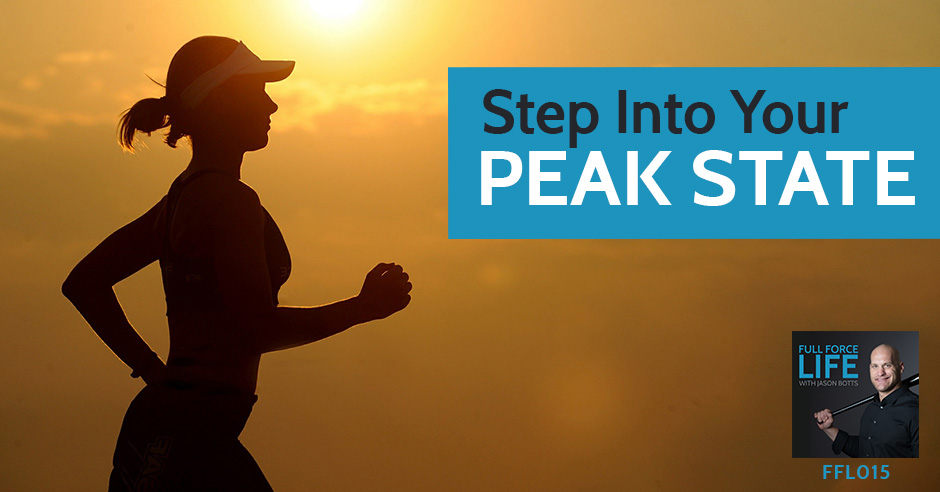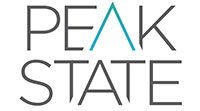
In this episode Coach Jason talks about the correlation between an athlete’s performance and the emotional state they bring to it. He explains the three forces that create any Peak State and how you can change or improve any one of them. He also walks you through in real time one of his most requested training tools that automatically triggers clients into their Peak State.
Listen to the podcast here:
Step Into Your Peak State
I’ve had a very interesting week. I just got back from the UP of Michigan, the Upper Peninsula, hanging out with the Yoopers. I got to do a little one-on-one with a new client. It inspired me, not only this time with this new client, but it’s been a theme these last couple of podcasts with the guests that we’ve brought in. We brought in Mindy Wender, a very successful business lady, and also Terrmel Sledge, a former Major League hitter, who’s also now the AA hitting coach for Los Angeles Dodgers. Something that they both touched on was this idea of the power of state, peak state. I know I call this show, The Full Force Life, but maybe you’ve caught in your ear that my website is JasonBottsPeakState.com. The idea of peak state was one of my original ideas of recognizing the importance of the state, having a great state management, as I’d like to call it, especially as an athlete, the emotional state.

When I talk about a peak state, what I’m talking about is the most resourceful emotional state that we can be in, that’s going to help us produce a specific result that we want. That’s an extremely complicated way of saying you’re never going to play better than you feel. When I go and I talk to these high school programs of academies, I say, “You’re never going to play better than you feel.” It does not happen. At least in baseball, it does not happen very often. If you’re feeling like a six, happy and confidence-wise, rarely are you going to have great games.
What we want to do is learn how to control how we feel separate from the environment, because life’s going to wear us down. It’s going to beat us down. If we let it, we’re going to be feeling not happy and not very good most of the time. Think about it. You leave the house and someone cuts you off. Are you going to be upset about it for the rest of the day? If you get an 0 for 4 or 1 for 4, are you going to mope around and feel bad? What happens if somehow the team comes back and you got that fifth at-bat and the game is going to be on the line, how are you going to bring your very best? You feel horrible and sad because you just had four outs, but how are you going to step into your very best state and come in and give your best for that next at-bat to help the team win the game. How do we do that? That’s what this podcast is going to be about.
I’m going to give you the three ways that we can change and influence how we feel on this moment. Then I’m going to give you a process, an actual technique that I’ve taught hundreds of kids already to use before pitches, before they make a pitch, before they get in there to hit a pitch. I’ve also done it with volleyball players, football players, a basketball player. If you’re a young athlete and you’re not a baseball player, this still will be a beneficial show. Also, if you’re not a young athlete, definitely do not use any of the tips or the strategies on the program. It’s only for young athletes. Just kidding. It can work in any environment, in any situation, in any avenue. It is something that I’ve it done before dates, this process I’m going to teach you towards the end, to put myself in the best peak state before I go out there.
We’re talking about the power of state. We talk about that it’s more important than any mechanics. Have you ever seen someone or maybe you’ve experienced it yourself, you had a great swing, but you’re not getting the results that you want? Today, this phenomenon, they call about the cage swing. We have so many great instructors out there. They’re teaching these kids how to have these great swings, they get in there, great swing in the cage, over and over and over again. Off batting practice, off flips, all there. They get in the game, something’s different and they’re not getting hits. They go back and they try to work harder in the cages, they work with a new instructor, whatever it is. Now, they get in the game and things feel even worse. Now, there’s more pressure and still they don’t produce the way they feel they should come game time.
One of those reasons why kids struggle to go from the cage into the batter’s box is because they do not enter the same peak state. They’re in a peak state in that batting cage, but for some reason, something changes. We’ll go through the three different specific things that could possibly change within them. In stepping in that game, one of those things is different or they’re all different, and they’re not in the same peak state in that batter’s box come game time.
Let me go ahead and explain the triad. The triad is not mine. It’s something that I learned through another program. When I took the certification course of the Robbins-Madanes Training, it’s about human need psychology. That Robbins is Tony Robbins who is the godfather. You’ve heard him mentioned on this show many, many times. He’s going to get reference more than anybody because he’s the godfather of coaching, the peak performance of business strategy, of life strategy. He’s the man. He is someone who’s able to take things that are really complex and break them down that they’re simple and easy to understand, much like this idea of the triad and the three parts, any emotional state.

We’re talking about of peak state. The number one fastest, easiest way to change how we feel to be able to step into this peak state is through our body, through our physiology. That’s how we stand, our body posture, how we move, how we breathe even. Each emotion has a certain pattern to how we use our body. I want you to go ahead and think about a sad and depressed person. What do they look like? Head up? Head down? It’s down, isn’t it? Shoulders back? Shoulders slouched forward? Slouched forward, am I right? Breathing full and deep or they’re breathing real shallow? Shallow, right? It’s hard to breathe deep when your shoulders are slouched forward and your head’s down. How about their voice? Real low and soft, isn’t it? How do you know that? Because you’ve seen it in other people. You’ve felt it and you’ve experienced it yourself the times you’ve been sad or maybe even depressed. It’s a pattern. It’s a pattern to how we use our body. The exact opposite is true as well. Someone who’s confident; shoulders back, their heads are up, they’re breathing real deep and full. They’ve got confident gestures. They have certainty in their movements. You can hear that tone of confidence in their voice. We’ve all gone and we’ve all experienced it before.
When I talk about the power of how we use our bodies, it goes even further than this BBL phenomenon that people like to talk about. Coaches can’t stand it with kids with bad body language. The parents can’t stand their kids with bad body language. But scientifically, it’s even more important than the opinions of your parents and making the team look bad, making yourself look bad. There’s scientific proof that how you carry your body controls how you feel. It determines how you feel. I just believe that the mind and the body are the same thing. You have your brain and you’ve got your body. The two are connected. I believe that connection is your mind. In order to have a strong mind, you have to have a strong body, a strong body posture. There’s this link between the two, between your brain and your body. Every time you’ve ever been confident, happy, excited, these empowering type of emotions, there’s been this link, this connection, to the happy, confident excited part of your brain. It works just the way every time you’ve been sad and depressed. That sad, depressed part of your brain has been activated as well.
If you immediately step into this confident physiology, even if you don’t feel that good, even if you had a lousy day, but all of a sudden you stand up tall, you stand up shoulders back, your head up, it automatically triggers that confident part of your brain. Now, you just start seeing things in a completely different light. You’re able to think differently. That’s the power of your physiology in controlling how you feel. You step into a confident body posture, automatically it’s triggered to think and see things in a more confident light. That’s the first part of the triad.
The second part is your focus, what you’re paying attention to. I already explained a little bit where, boom, there’s this part of your brain that’s confident. There’s this other little part of your brain that’s sad and depressed and any other emotion. One of the other ways is what we focus on, what we pay attention to. Are we going to start looking for things that are positive or we can continue to look at things that are more negative that support how we don’t feel good? Are we looking for things that support how bad we are when we play? That’s the power of our focus.

One of my mentors, the great Dave Austin, he says, “What you feed will grow and what you starve will die.” If you go out there and you keep looking for reasons why you suck or you’re not playing well, you’re going to find them. Even if they’re not true, you’re going to find some information that supports the questions that you’re asking yourself. Why am I not very good? Your brain is like, “Let me find an answer for that.” Same thing works on the confident side. If you’re asking, “I’m a great player. How can I be an even better player?” Your brain is out there going, “How can I be better today?” That’s the power of focus.
You want to know the easiest, simplest way to control your focus, is those questions. Be careful and be intentional with the power of the questions that you ask, because your brain will find an answer for it. How can I be better? How can I play better? What’s great about what I do already? What’s great about what I’ve done in the past? That controls our focus. If you want to step into a peak state, ask yourself, “When I was at my best, when I’ve been in a peak state before, what am I doing? How can I do it now?”
The third part of this triad is language. Not only the language we speak out loud, but the language inside our head, our self-talk. That’s going to control how we feel. What goes on in your head? I’m going to tell you right now, that’s a pretty tricky thing to change. It’s not very easy to change your thinking. But it’s a much faster way. You change the words that you speak aloud, it’s going to interrupt the pattern of what’s going on inside you. You start speaking intentionally more positive language to yourself out loud, to other people, it’s going to start changing the way you think. It’s also about the ability to give yourself meaning. You’ve got to become masters of meaning, looking for things that support your focus, support your peak state. What are all the things that you’ve done well? That’s a great example of how we use language.
When you look at a 1 for 4, a 1 for 4, for most athletes, for most baseball players, softball players, a 1 for 4 is not really a great day. But what if you start dissecting it and breaking it down? “I got that great hit and I hit another ball really hard, and another ball pretty hard. That recreates at-bats, quality at-bats.” That’s the ability to make meaning. The results weren’t there but we dissected it and we found things that support our confidence, our happiness, our results towards getting to our goals. That’s the power of meaning, the power of language. That’s the third way we can change our state, by taking something that it could be good, it could be bad, but how can we shine it up and face in an angle that supports us so we do feel good.
I told you about this trip going to the UP, I had this young client, very young. Usually, I don’t do stuff on the field baseball-wise, usually I don’t work with kids as young as he was, but it was something that I was really interested in. I wanted to go up there anyway. It’s just perfect timing, perfect people to do it with. I went ahead and did it. I’m so grateful I did because, one, and had an absolute blast with the environment and being a Yooper for a couple of days and being with this incredible family, and also working with this very special, very talented, intelligent kid. It was so cool to see his progress on the field. What we did was we basically worked these three parts of this triad. We created them in such a way that they’d became a habit any time he touched the bat and stepped in batter’s box.

If you listened to the past episodes, especially the one with Dave Austin, he taught us about RESPA. RESPA’s where we take a deep breath in, and then we evaluate things for what they really are. We come up with a game plan, have a little bit of patience, then we take action. I use these auditory triggers with him, these names. I have this young kid. He stepped in the batter’s box. Automatically, he goes RESPA. He had to take a deep breath to relax all his muscles, all the tension, let it all go out of his body. He had RESPA, take a deep breath, and then I use the trigger of VALDEPA. VALDEPA is our trigger to visualize, to see our results in advance. Automatically, after he took his deep breath and he RESPA-ed, he’d have to see a line drive off the middle. Then I used the next thing, LASPRO. LASPRO’s our animal trigger to narrow our thoughts, narrow our intentions. His intention that I taught him was, “I want you to say ‘Ball”’ out loud. All I want you to do is focus on the ball when you get to this point of your stance and you’re about to hit in the game.” I’d go, “RESPA, VALDEPA, LASPRO.”
What that did was it trained his physiology to be relaxed, to be in a peak state physically. His focus was on a great result that he just visualized. Then his language and his focus was just on the ball. We did that hundreds and hundreds of times over six days where it became automatic to his approach in the plate. Even when I’m not there, he goes out that night, his first at-bat off live, kid pitching and he goes out there and rips a single. This was a kid who two and a half days before was afraid of the ball, afraid to hit off kids, and was very inconsistent, a little all over the place with the swing. But now he had this incredible ability to put himself in a great state no matter what, because we trained it to be a habit. That’s what I want to do in the next stage of this podcast, is to be able to put you through an anchor process where you can develop and create your own anchor, so you could step into your peak state whenever you need it. This is something I’ve taught to hundreds and hundreds of kids already.
The last part of this podcast, now that we’re not driving around hopefully, hopefully, we’re in a place we got a little bit of space. We need to be able to take a full step into something for this anchor-building exercise. When I mean anchor, it’s something that automatically triggers us to feel a certain way, something from the environment. When I talked about my young client up in the UP of Michigan, I’d given him these auditory anchors where every time I said certain words, it triggered him to do and think or feel a certain way. Basically, I triggered him into his peak state.
We’re going to do the same thing, but with what I call a spatial anchor. Let’s take it from an NLP process called The Circle of Excellence. I’ve modified it and adapted it so it works even better with athletes. What it is, we are going to have a circle on the floor. All I want you to do is stand up, shake your body out, get loose, take a deep breath, whatever you need to do to be prepared. Look on the floor and see that there’s an imaginary circle. It’s a little bit wider than your feet.
Out of curiosity, what color is your circle? It’s one of my favorite questions to ask when I’m doing this in person. It’s great, all the different answers you get. We all have different colors of circles. In fact, some people can’t even see a circle. If you’re one of those people right now, go ahead and just feel that one is there. It’s going to work just the same, I promise you. I’ve even had one client who says she could not see or feel a circle but she could hear one. My brain doesn’t work that way, but it seemed to work well enough for her. If you can’t see or feel, go ahead and hear your circle.

Inside this circle is going to be a memory of one of the elitest greatest performances of your career. What I want you to do when you’re ready is go ahead and take a step inside the circle and step inside your body and replay this elite performance. It’s going to be very important when you do it that you do it looking outside your own eyes, looking outside your body, looking out your own eyes. When you’re ready, go ahead and step into this confident elite memory. Step in there. Replay this performance, seeing out of your own eyes, seeing what you saw, hear what you heard, feel what you felt, see it, feel it, own it. Remember those feelings of just knowing. You knew you were going to come through.
We had Terrmel Sledge on here and he talked about when he stepped into his state, he was just, “I knew I was going to get the job.” Feel that sense of certainty back then. Feel it in your body now. Feel it growing bigger and stronger. See what you saw. See it bigger and brighter. See it closer to your face. Make it more intense in your body. When you’re ready, go ahead and leave all these feelings, leave all these feelings inside the circle and step on out.
We’re going to test and make sure we’re on the right path. Now that all that is left inside this imaginary circle, what I want you to do is I want you to look up. I want you to say your telephone number out loud backwards. Remember, look up. It will make it easier. What I want you to do is I want you to see that circle on the floor and go ahead and step on back into it when you’re ready. Go ahead and do it now. You’ll feel yourself go back to that memory. You’ll feel that little bit of state change. You’re going to feel that little bit of that sense of confidence come back into your body, all that energy.
Now that we know that it works, what I want you to do is I want you to go ahead and step on out, leave all that energy, all that emotion, that peak state inside that circle, step on out and we’re going to begin to build and strengthen it and condition it. It’s going to be something you’re going to need to do even more on your own if you are really taking advantage of it as a tool. Go ahead and think of another memory, an elite performance, a great game, see it inside your circle and go ahead when you’re ready.

Go ahead now and step inside it, and see what you saw then. See it out of your own eyes, see it big, see it bright, see it close to face, see when you’re zooming in. Feel what you feel. Feel the intensity of this confidence, of this peak state, of this knowing inside your body. Feel it grow and expand. What you feed will grow. Feel it grow inside you now. Hear what you heard, this great performance. When you’re ready, go ahead and leave all this increased confidence, this increased peak state, leave it all inside of the circle and step on out. One more time, now we’re really going to what I call lead it. We’re going to make it even better than anything we’ve ever experienced.
What I want you to do is imagine five years down the road. Five years, you’re physically stronger, you’re more skilled athletically, mechanically. Five years of training and conditioning yourself to be a better player. Think of what that player looks like now and where you’re going to be in five years. Think of the confidence you’re going to have as a player in five years. See that all. See that person in that life inside the circle now. When you’re ready now, go ahead and step into that body and see it out of your own eyes, this future you, and feel their confidence, feel it now. See their life. See how they play the game, looking out their own eyes. Hear the sounds. What do they say in their own head? What do they think about themselves? What are the sounds around them? What do people tell them about them? How great are they?
Go ahead and add all that and feel the certainty. Feel the confidence of five years in the future, how great life is going to be. Feel the peak state you’re going to be experiencing daily consistently in five years from now. Feel it now. Build up strong in your body now. Double the intensity of it, build it stronger and stronger in your body now, and go ahead and just leave it all. Leave this peak state inside this circle and step on out. Very good.
We now have this anchor. It’s going to be something that you can build stronger and stronger. Anytime you need this circle, you need to step into your peak state to perform, to be your very best. You now got it. It could be something that when you leave the dugout, you can step into and be something before you get in the batter’s box. It’s something you can do before the game. It’s something that you can do pitch to pitch. Always step into your circle. Stand in your peak state.
One of my one-on-one private client, softball player, the softball pitching mounds are big circles. That’s her circle of excellence. That’s her peak state circle. She’s trained her mind that any time she steps into that circle, boom, she’s in her peak state. She’s had some pretty impressive seasons since she’s done that. It’s a tool that you must learn to condition and develop and use. It won’t work if you don’t use it. I encourage you to take the time, one, two, three minutes a day, in the mornings, at night, before practice, during practice, whatever it is. Spend at least three minutes a day conditioning this inside of you. This tool, this technique, this resource is going to help you bring your peak state, that body, that focus in that language to your performance each and every day.
Definitely, as always, reach out, let me know how it goes. Any questions, comments, criticisms, or sarcastic remarks, you can always reach out to info@JasonBottsPeakState.com.
Until next time, we got some more great guests coming up in these next couple of weeks. Until then, aim high, swing hard, smile often, and live full force.
